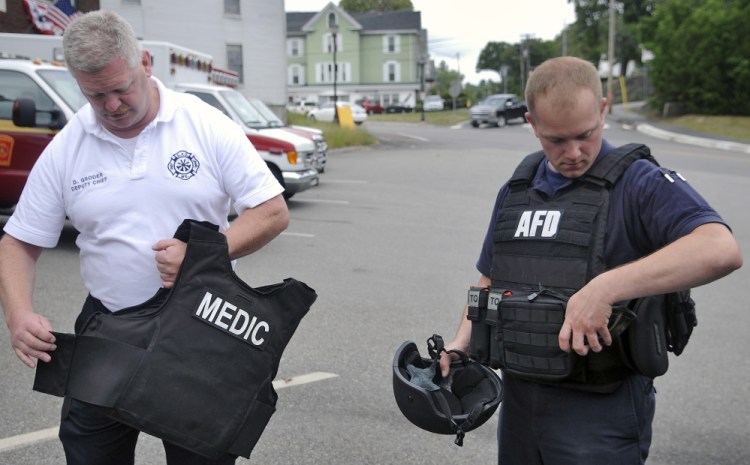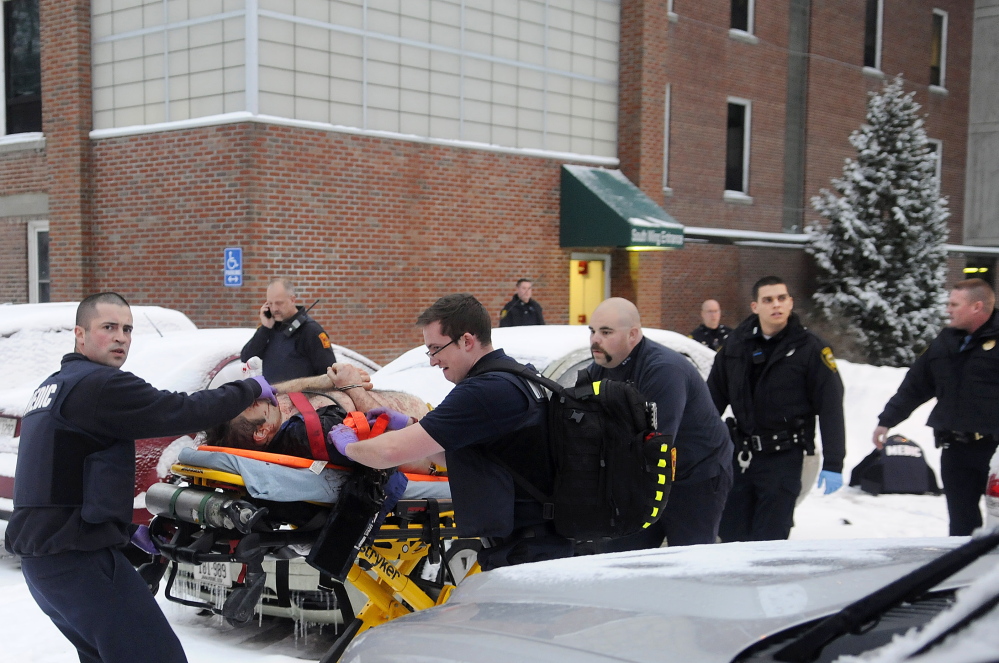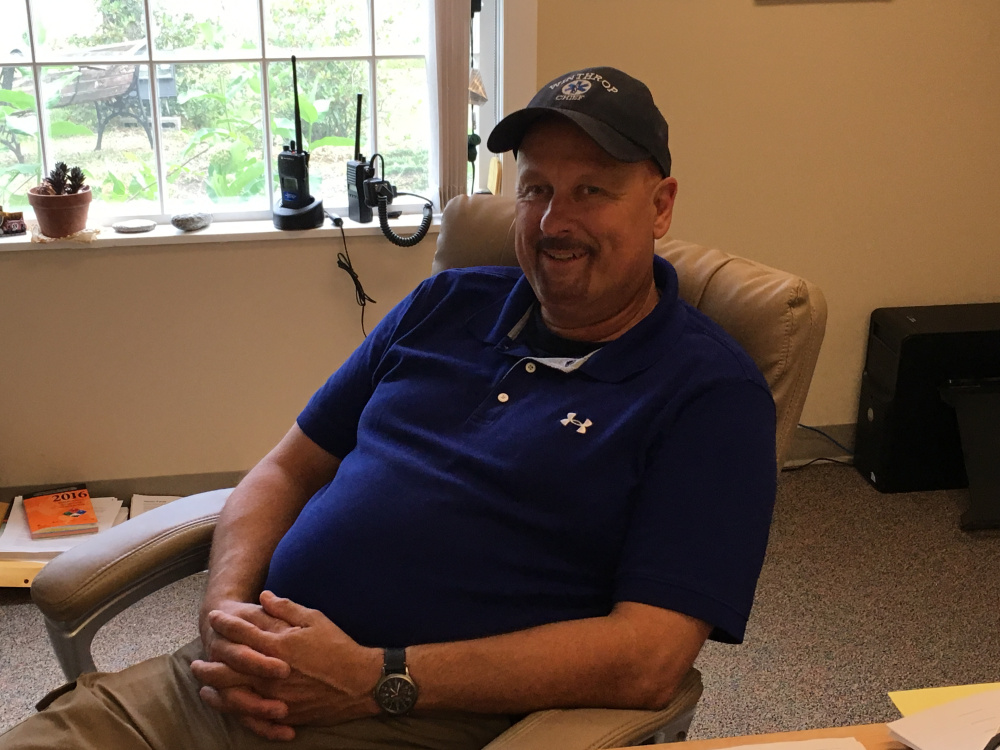WINTHROP — When John Dovinsky was growing up in the busy West Coast city of San Diego and entering the field of emergency medicine, gun violence and heroin abuse seemed like urban problems.
But now that he has worked in Maine for a number of years and oversees seven largely rural towns as director of the Winthrop Ambulance Service, his outlook has changed. He has seen many people overdose on opiates. While he still thinks Maine is a great place to raise a family, Dovinksy said he is now getting ready to order two types of bulletproof vests for his crew members.
Dovinsky has been considering the safety gear for several years and for a variety of reasons.
It can be difficult for more than one law enforcement officer to arrive at a crime scene before his technicians start treating victims, Dovinsky said, and with mass shootings and terrorists attacks in the news, his department has developed a plan for responding to active shooter situations in schools.
What’s more, the surge in drug overdoses that his department responds to has presented its own set of risks: People brought back from an overdose can act violently and sometimes have weapons nearby.
“I’ve been in (emergency medical services) for 24 years. I have been through the planning or the pre-planning for all types of threats, and that really happened after 9/11,” Dovinsky said, referring to the terrorist attacks on Sept. 11, 2001.
He said there’s no way to know if there would ever be an active shooter situation locally, but it can’t be ruled out either.
“I think all we can do is look at what the trends nationally have been,” he said. “It’s been big cities and little cities. It’s been urban and rural. In order for me to do my job and have my folks be able to do their jobs to the best that they can, we need to be prepared for anything.”
The Winthrop Ambulance Service isn’t the only emergency medical service in central Maine outfitting itself with safety gear.
The Augusta, Waterville and Winslow fire departments — all of which provide ambulance services — have each obtained different types of bulletproof vests. Delta Ambulance Service is considering buying them too, said Executive Director Tim Beals.
Their investments hint at the changing safety landscape for emergency responders across the country. Police officers are traditionally thought of as the ones who put their lives on the line, but according to ambulance personnel and firefighters here, they are also at risk when responding to injuries, emergencies, crime scenes and fires.
Both Dovinsky and Deputy Chief David Groder of the Augusta Fire Department pointed to yet another reason that more safety gear is required for public safety professionals: Violence appears to be increasing against them.
Statewide, there was an uptick in the number of Mainers who allegedly assaulted emergency medical providers. In 2010, just 12 Mainers were charged with assaulting an emergency medical care provider. That number hovered around 16 for the next four years before climbing to 21 in 2015.
The Winthrop Ambulance Service is buying 24 sets of lighter weight bulletproof vests (each worth $640) with $11,000 raised by the town of Winthrop and lesser amounts contributed by other member towns, Dovinsky said. With a grant from the Maine Emergency Management Agency, the service is also purchasing heavier duty tactical vests that are designed for active shooter situations and will be accompanied by helmets and goggles.
Dovinsky didn’t know the dollar amount of that grant yet, but when the Augusta Fire Department purchased similar gear with state funds in 2014, Groder said it cost around $20,000.
Firefighters wore that equipment when responding to the Wal-Mart parking lot last weekend after a dispute led to two groups of people shooting at each other from cars parked side-by-side, Groder said.
“Once the scene was cleared, we rolled in and checked for any potential victims,” he recalled. “In this case there wasn’t anyone on the scene that needed to be treated. But safety being the way it is, we had the equipment and we wore it.”
But it’s not always such high profile crimes where paramedics and firefighters can benefit from the extra protection, Groder said. He referred to a fire that was reported on Sand Hill in Augusta last fall. The homeowner verbally threatened firefighters who arrived at the scene, he said, so they left and waited for a police officer to arrive.
The Winthrop Ambulance Service has never entered a situation that involved a weapon, and it always waits for at least one law enforcement officer to arrive on the scene before responding, Dovinsky said. But with a large population of gun owners and few designated police departments in their service area, the potential nevertheless exists that emergency medical providers could respond to a dangerous situation, he said.
“It’s nothing compared to the potential physical and long-term costs of a knife or gunshot wound,” he said. “You have to remember, if you’re traumatically injured, just getting wheeled in the door of a trauma center costs $5,000. This is just an added layer of protection.”
Dovinsky said his department will be creating a policy to govern when the new equipment should be worn.
According to Dovinsky, the shooting in Columbine High School in 1999 led to many of the changes now underway among emergency responders nationwide. Police were slow to clear the school after that shooting, which delayed medical providers from attending to the injured, a number of whom bled to death.
In 2013, the Maine Emergency Medical Services bureau released a set of recommended guidelines for departments responding to active shooter events. It highlighted the importance of treating wounds quickly and wearing the right gear.
Now, along with their protective equipment, Winthrop, Augusta, Waterville and Winslow responders have all been learning ways to quickly find and treat victims who are bleeding after an encounter with an active shooter, using tourniquets and other techniques more typically associated with the battlefield.
The Augusta department does not have a set policy for when its members should wear vests, Groder said, but they typically do so when responding to situations that police are also called to, including suicide attempts, domestic violence reports, fights and overdoses.
Groder did not discount the risk, however haunting, that Augusta could one day be the site of something worse, like a mass shooting.
“The only thing I can say is it’s a changing environment that we’re working in, and we’re doing our best to prepare,” he said. “If you had two cars that can park side-by-side by each other at Wal-Mart and just start wailing each other with lead, I mean, it’s here.”
Charles Eichacker — 621-5642
Twitter: @ceichacker
Send questions/comments to the editors.






Success. Please wait for the page to reload. If the page does not reload within 5 seconds, please refresh the page.
Enter your email and password to access comments.
Hi, to comment on stories you must . This profile is in addition to your subscription and website login.
Already have a commenting profile? .
Invalid username/password.
Please check your email to confirm and complete your registration.
Only subscribers are eligible to post comments. Please subscribe or login first for digital access. Here’s why.
Use the form below to reset your password. When you've submitted your account email, we will send an email with a reset code.